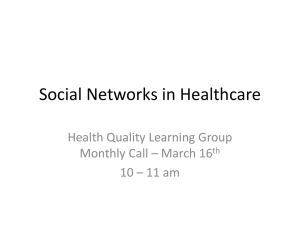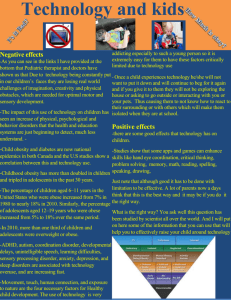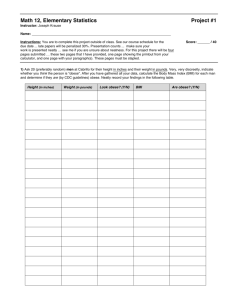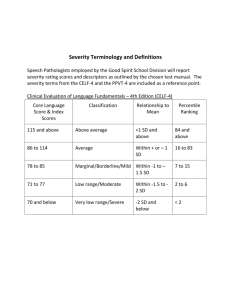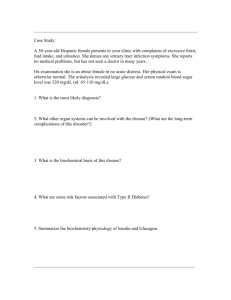Collaborative System Modeling to Inform Childhood Obesity Prevention Policies
advertisement
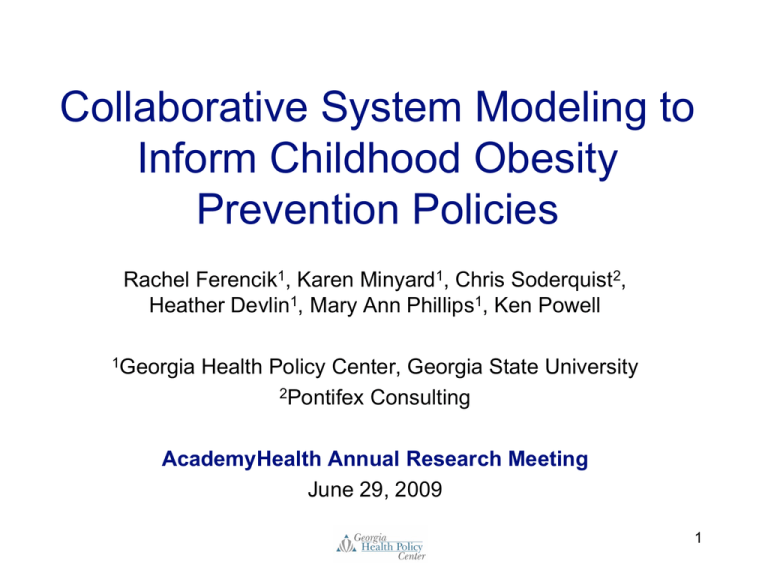
Collaborative System Modeling to
Inform Childhood Obesity
Prevention Policies
Rachel Ferencik1, Karen Minyard1, Chris Soderquist2,
Heather Devlin1, Mary Ann Phillips1, Ken Powell
1Georgia
Health Policy Center, Georgia State University
2Pontifex Consulting
AcademyHealth Annual Research Meeting
June 29, 2009
1
Research Objective
• To provide policymakers with a systems
perspective that supports more rigorous
discussions of policy alternatives to
reduce childhood obesity
2
A Range of Systems Thinking Skills
Build Complex
Models
2%
Apply A Basic
Systems Thinking
Framework
95-100%
Build
Simple Maps
40-50%
Build
Simple
Models
15-20%
3
Applying Systems Thinking
Looking for ways to create a more desirable future
Trends in prevalence of overweight* among
children aged 2 to <5 years in WIC Program,
Georgia, 1985-2006
16
14
Percent
12
10
8
6
4
2
5
6
7
8
9
0
1
2
3
4
5
6
7
8
9
0
1
2
3
4
5
6
1 98
1 98
1 98
1 98
1 98
1 99
1 99
1 99
1 99
1 99
1 99
1 99
1 99
1 99
1 99
2 00
2 00
2 00
2 00
2 00
2 00
2 00
0
2010
2020
Year
* Body mass index for age ≥95th percentile
Source: Pediatric Nutrition Surveillance System (PedNSS)
4
Collaborative System Mapping
Stocks and Flows
Healthy
& Safe
Population
becoming
at risk
Afflicted &
Chronic
Population
At Risk
Population
becoming
afflicted
returning to
healthy & safe
dying from
chronic
complications
Study Design
Collaborative System Modeling
6
Collaborative Modeling
Experts provide input
to model
Model is used to
rigorously tests assumptions
Legislators & Staff
Juntos switch
1:
2:
Juntos Demand
Assumptions
1: MicroN
800
200
2: Vaccines
View Financials
1
1
2
2
1
1:
2:
400
100
Financial assumptions
2
1
2
Run
Nutritionists
Reset
1:
2:
1
2
0
0
0.00
30.00
60.00
Weeks
Page 2
0
2
90.00
120.00
6:07 AM Thu, Sep 27, 2007
Supplies
0
Recommended Visits Juntos
Vaccines
clinic visits recommended juntos by age[age 0 to 6 meses,Healthy] 4
Vaccines
88
clinic visits recommended juntÉy age[age 0 to 6 meses,Problem]
4
Vaccines on Order
88
clinic visits recommended juntÉy age[age 7 to 24 meses,Healthy]
4
desired weekÉupply vaccines
8
weeks to receÉrdered vaccine
8
clinic visits recommended juntÉ age[age 7 to 24 meses,Problem] 4
expectÉ patient
0
4
0
20
20
0
30
0
Staff Able to
Fully Meet
Requirements
week to
begin
training
max cliÉer staff
8
15
4
Staff Unable to
Fully Meet
Requirements
40
normal non clinic
hours per staff
per week
Epidemiologists
Ni–os above
2 Z scores
age 0 to 6 meses
ni–os being born
above 2 Z scores
becoming 7 meses
falling below %
0 to 6 meses
Ni–os above
2 Z scores
age 7 to 24 meses
total births
moving above
2 Z scores
age 0 to 6 meses
~
falling below
2 Z scores
age 7 to 24 meses
above 2 Z scores
becoming 6 a–os
falling %
7 to 24 meses 2
falling %
7 to 24 meses
becoming 7
meses logic
probability o
birth weight below 2 Z
due to mother's health
Ni–os above
2 Z scores
age 2 to 5 a–os
above 2 Z scores
becoming 2 a–os
moving above
2 Z scores
age 7 to 24 meses
becoming 2
anos logic
becoming 6
anos logic
falling below
2 to 5 a–os
moving above
2 to 5 a–os
falling below
2 Z scores
age 0 to 6 meses
ni–os expected to
change nutrition status
Physical Activity
Experts
Economists
ni–os born
below 2 Z scores
Ni–os below
2 Z scores
aged 0 to 6 meses
below 2 Z scores
becoming 7 meses
Ni–os below
2 Z scores
age 7 to 24 meses
below 2 Z scores
becoming 2 a–os
Ni–os below
2 Z scores
age 2 to 5 anos
below 2 z scores
becoming 6 anos
The Process
• Develop
Purpose
• Build/Revise
Model
• Test Model
• Add/Revise
Policies
• Test Policies
• Engage
Policymakers
7
Perspectives on models
Voices from the cynic to mystic
Cynic
Realist
Mystic
“It’s only a model!”
“The world is much
more complex, so
it’s not useful.”
“Our situation is
unique so your
model doesn’t
apply.”
“I use models all the time to
make decisions, they’re just
implicit and usually
untested.”
“I can use a model to make
my assumptions explicit,
share them, improve them,
and test them.”
“It will improve our ability to
rigorously discuss the
issues!”
“It can predict the
future.”
“If I can just get
everything into the
model, then it will
be perfect.”
“All models are wrong, some are useful!”
-Box & Deming
System map
Children age and become obese
births
healthy
interv entions to
help children become
not obese
Pre School
Non
Obese
PreK
becoming
obese
preK
Elementary School
nonobese
entering K
Non
Obese
K to 5th
becoming
nonobese
preK
Obese
PreK
obese
entering K
Non
Obese
6th to 8th
becoming
nonobese
K to 5th
becoming
obese
K to 5th
interv entions to
keep children
f rom becoming obese
Middle School
nonobese
entering 6th
becoming
nonobese
6th to 8th
becoming
obese
6th to 8th
Obese
K to 5th
Obese
6th to 8th
obese
entering 6th
High School
nonobese
entering 9th
Non
Obese
9th to 12th
nonobese
exiting
becoming
nonobese
9th to 12th
becoming
obese
9th to 12th
Obese
9th to 12th
obese
entering 9th
obese
exiting
9
Policy Options
• Improve physical education in school
• Eliminate a lá carte food sales in schools
• Ensure safe routes to school
• Improve nutrition & physical activity education in after
school programs
• Improve nutrition & physical activity education in
preschool programs
• Reimburse Medical Nutrition Therapy for obese
children on Medicaid
10
Principal Findings
11
Conclusion & Implications
• This process brought together
legislators, researchers, and other
experts to develop a set of actionable
policy options to address childhood
obesity.
• Focus is not on finding “the answer” but
on supporting a more rigorous
conversation.
14
Contact Info
Rachel Ferencik
Georgia Health Policy Center
Andrew Young School of Policy Studies
Georgia State University
404-413-0307
rachel@gsu.edu
15
Appendix A
Weight Categories Used in the Model
Infants (0-23 months)
Data is from CDC/NHANES 2006 for Weight
for Recumbent Length (WRL)
– Not overweight: WRL<85th percentile;
– Moderately overweight: WRL>85th percentile and
<95th percentile;
– Obese: WRL>95th percentile and <99th
percentile;
– Severely obese: WRL>99th percentile. ・
Youth (2-19 years)
Based on comparison of BMI to standard
growth chart percentiles.
– Not overweight: BMI<{85th percentile or 25};
– Moderately overweight: BMI>{85th percentile
and 25} and <{95th percentile or 30};
– Obese: BMI>{95th percentile and 30} and <{99th
percentile or 35};
– Severely obese: BMI>{99th percentile and 35}.
16
Applying Systems Thinking
The following curve is instructive regarding how to apply system dynamics
Value/
Utility
Complex model/interface
“Mother of all Models”
Simple model/interface
Simple stock & flow map
“Conversational” use of thinking skills
Effort/Time Expended;
Skill Required
There’s value to be added at many points along the curve!
